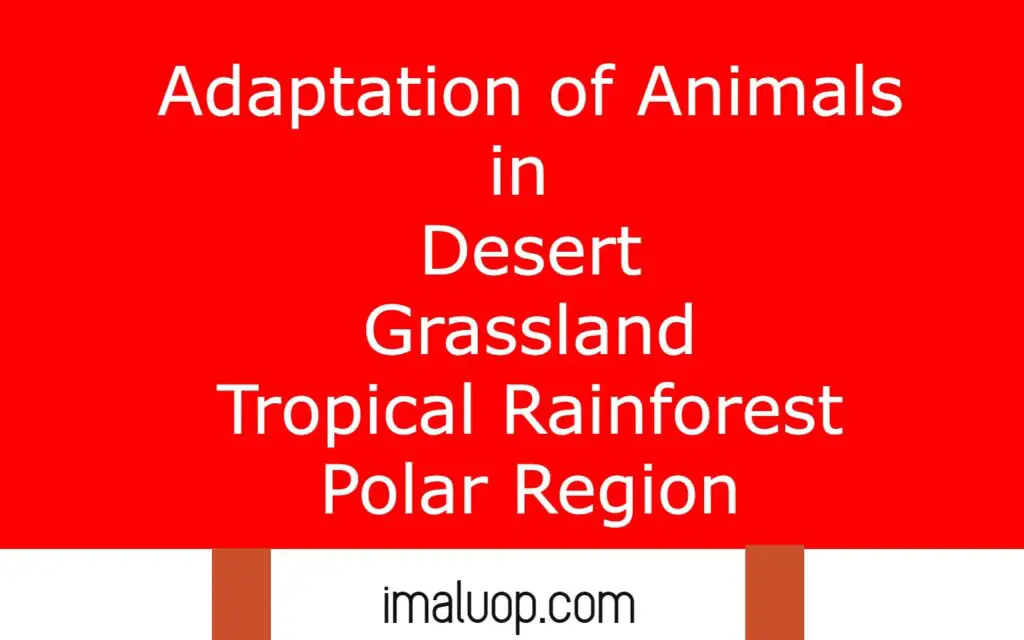Hi, today we will discuss different types of Adaptation in Animals of Different Environment. But before we learn more about adaptation in animals we should have proper knowledge about what is adaptation, its types and examples.
Adaptation in animals shows us the image of the environmental conditions in which they live. Different animals adapt depending upon their geographical regions where they live. We will learn how animals can adjust themselves in different conditions one by one:
Table of Contents
Adaptation of Animals in Desert:
You may be aware that in desert temperature changes are extreme. During daytime the animals have to face very high temperatures while during night they have to tolerate very cold conditions. You can not expect a sufficient amount of water in the desert. Rain is very rare in the desert so it can be negligible as a water source.

It may seem to be impossible to live there permanently. But a large number of animal species live there without any problems permanently. Now think how they can live to such extreme conditions. Desert adaptation to those animals makes it possible.
For example replies, camel, birds, fox live in the desert show adaptation for water conservation, protection against excess heat. Now we will list all the adaptations which make them suitable in the desert.
- Water Conservative Modes of Excretion:
Animals living in the desert must adapt for water conservation. Snakes and other reptiles present in desert excrete uric acid which saves a lot of water loss during excretion. Because uric acid is insoluble in water and they can excrete it in a semi-solid state which helps to retain water in the environment where water is not available easily.
- Sweating is very Less to Conserve Water:
Most of the animals in the desert can tolerate a high temperature so they do not sweat which again is an adaptation for water conservation. Think if sweat much then how much water will lose only for cooling their body.
- Most Animals are Nocturnal:
In desert temperature is very high during daytime but at night temperature is low but at this time water loss is at least minimum. So major animals in the desert become active during night which helps them to avoid water loss and excess heat. Some animals become active during dawn and dusk which also give the same benefits of night.
- Extra Sources of Water:
Natural waters source is very limited in desert so animals in desert are mostly dependent on succulent plants for water. They also have Adaptation for eating cactus which is not so easy for other animals not living in the desert.
Adaptation in Animals in Grassland:
Animals living in grasslands do not face extreme conditions like deserts, it is true but they also need some adaptation. In grassland major plants are grass which is not good food for all animals. The grassland barrier is very less so it becomes an open space for predators and prey. Now we will list some adaptations specially needed for grassland.

- Camouflage:
Skins colour in grassland is very important because grassland is open space for both predators and prey. So skin colour should be similar to the environment where they live which helps them to remain unnoticed.
- Adaptation in Digestive System:
The herbivores animals present in grassland take grass as food in major cases. Grass is not delicate like other vegetation so their teeth and digestive system are adapted for eating grass.
- Night Time Feeding:
During daytime water loss is high in grassland so herbivores like antelope as well as carnivores feed during night to avoid water loss.
Adaptation in Animals in Tropical Rainforest:
Tropical rainforests are also extreme to some extent. Because here rainfall is much higher than other regions and temperature during summer is much higher, sometimes reaching 40 degree centigrade. In winter time temperature remains much higher as compared to other regions so animals present in tropical rainforest also need some specific adaptation. We will now know about various adaptations required for animals for living in tropical rainforest.
- Mimicry:
Animals present in tropical rainforests hide themselves using a biological phenomenon called mimicry. Animals mimic natural objects or dangerous, venomous animals which helps them against predators. For example an insect mimics dried twigs which makes them hide in the surrounding environment.
- Camouflage:
Some animals use camouflage to protect themselves against various predators and predators also use it to remain unnoticed to prey.
Adaptation in Animals in Polar Region:
Animals present in the Polar Region face very extreme environmental conditions and they need some adaptation to sustain in such extreme cold conditions. Temperatures during winter reach almost minus 36 degree centigrade and whole year polar regions covered by snow.
Not only that, continuously six months sun do not rise and continuously six months sun do not set. So animals present in the Polar Region must have some special adaptation to overcome the extremities in the Polar Region.
- Dense Fur Give Protection Against Extreme Cold:
Animals have dense fur even on the sole of feet which insulate their body heat. They have to walk on snow and fur on the sole of feet gives some protection against slipping on snow. White colour fur helps them to remain unnoticed by other predators and prey animals.

- Blubber Give Insulation:
Most of the animals that live in the cold ocean have a very thick layer of fat, blubber which gives them insulation for heat loss. The stored fat in blubber can be used as energy resources when animals in polar regions undergo hibernation.
Reference: Adaptation in Animals of Different Environment
Hi Everyone!!! Welcome to Imaluop. Imaluop always try to learn some new and he want to share to other people. Here we will try to learn various topics on Science, specially on Biological Sciences.
